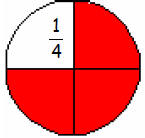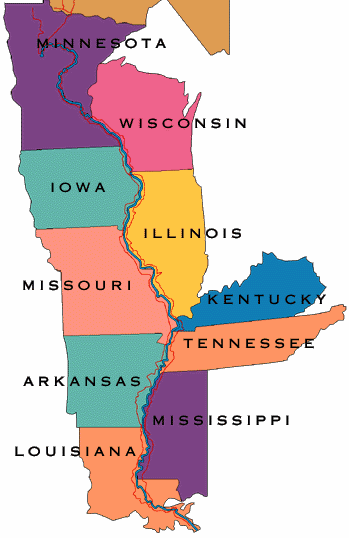Dividing the Mississippi River
Intended for Grade: Fourth
Subject: Math and Science
Description: This activity is designed around the Mississippi River and the states it borders. The activity includes determining fractions, and adding and subtracting fractions.
Objective: The student will be able to determine fractions and add and subtract fractions with like and unlike denominators.
Mississippi Frameworks addressed:
• Math Framework 6a: Read and write six-digit whole numbers, decimal numbers
through hundredths, and fractions.
• Math Framework 6b: Order and compare six -digit whole numbers, decimal numbers
through hundredths, and fractions with denominators of twelve or less.
• Math Framework 7c: Multiply whole numbers by one- digit multipliers , and divide
by one-digit divisors, with and without remainders.
• Math Framework 7h: Add and subtract fractions with like and unlike
denominators .
• Math Framework 7i: Apply problem solving techniques to solve one and two- step
problems involving the basic operations .
National Standards addressed:
• Math Standard: Number and Operations
• Math Standard: Communication
• Math Standard: Problem Solving
Materials:
• Map of the entire Mississippi River and the states that surround it
• Mississippi River fraction circles
• Regular fraction circles
Background:
The Mississippi River either runs through or along the border of several states. These states are Louisiana, Mississippi, Arkansas, Tennessee, Kentucky, Missouri, Illinois, Iowa, Wisconsin, and Minnesota. However, we will only consider the states which are, at least in part , east of the River, i.e. Louisiana, Mississippi, Tennessee, Kentucky, Illinois, Wisconsin, and Minnesota. When considering the length of river attributable to Louisiana and Minnesota, we only measure the portion cutting through the state as the portions defining the border for those states also border other states on our list.
A fraction is a number that is represented by a numerator over
a denominator: 
Fractions represent a part of a whole. If a whole object is divided into parts , then the numerator is the number of parts the fraction represents and the denominator is the number of parts that make up the whole.
Example:

This whole circle is divided into 4 parts. 4 will be the denominator of the fraction. 3 parts of the 4 parts are colored red, so the fraction representing the red parts of the circle is 3/4. The fraction representing the uncolored parts of the circle is 1/4.
A fraction is in simplest form when the numerator and denominator have no common factor. For example, the fraction 6/16 is not in simplest form because 6 and 16 share a factor of 2. In simplest form, 6/16 is 3/8. Notice that 3 and 8 have no common factor.
When adding and subtracting fractions with like
denominators , you are really only adding the numerators. For example,

To add fractions with unlike denominators, you must first
find the least common denominator of both fractions. The least common
denominator may also be described as the least common multiple or LCM because it
is the smallest number that is a multiple of both denominators. To find the LCM
of two numbers , write down the multiples of each until you find one they have in
common. For example, find the LCM of 4 and 6.
List the multiples of 4: 4, 8, 12, 16, …
List the multiples of 6: 6, 12, 18, …
So 12 is the smallest number that is a multiple of both 4 and 6.
Once the least common denominator has been found, we must
obtain equivalent fractions to those in the original problem such that both have
the LCM in the denominator. If we wanted to add
 , we would first need to determine
, we would first need to determine
 and
and  .
Since 12 divided by 4 is 3 and 3 times 1 is three ,
.
Since 12 divided by 4 is 3 and 3 times 1 is three ,
 and since 12 divided by 6 is 2 and 2 times 3
is 6,
and since 12 divided by 6 is 2 and 2 times 3
is 6,  . So
. So
 . The same concept applies to subtraction.
. The same concept applies to subtraction.
Manipulatives like fraction circles are often a great help in explaining fractions to students. The fraction circles are simply circles cut out of construction paper, sliced into equal sized pieces, and labeled. In the example below each segment should be labeled 1/4. You would do the same thing for the Mississippi River fraction circles except for instead of writing fractions on each segment, glue a picture of the state on the front of the segment representing the proportion of that state’s border along the Mississippi River.

Procedure:
1.Introduce fractions. Make sure the students understand that a fraction represents some part of a whole. Use the fraction circles to demonstrate.
2.Show the students how to use the fraction circles to help them add fractions.
3.Hand out maps of the United States highlighting the Mississippi River and the “Dividing the Mississippi River” Worksheet to the students.
4.Have the students answer the first three questions.
5.Divide the students into groups of two. Arm each pair with a complete set of fraction circles and a set of Mississippi River fraction circles.
6.Have the students complete the remainder of the worksheet.
7.Once the students have completed the worksheet, discuss question 20 as a class. Solicit ideas as to how they might determine what fraction of the River borders every state except Wisconsin. [Answer: They could sum the lengths attributed to every other state or (and even better) they could subtract the fraction attributed to Wisconsin from 1.]
Evaluation:
Students successfully complete the worksheet.
Extended Activities:
Have the students do the same for the states west of the Mississippi River.
Repeat the activity using decimals instead of fractions.
Source:
Accessed 2005 December 12.
Prepared by:
Emlee Nicholson
NSF NMGK-8
University of Mississippi
December 2005
Dividing the Mississippi River
Directions: Using your map of the Mississippi River and the Mississippi River fraction circles, answer the following questions.
1. Look at your map of the United States. Which of the states bordering the Mississippi River to the east (these states lie to the right of the river on your map) has the largest border along the Mississippi River?
2. Which of these states would you think has the smallest border along the Mississippi River?
3. What fraction of the river would you estimate borders Mississippi?_____________
Suppose we took a string and a ruler and measured the
river on your map state by state and got the results below.
State
| State | River length (inches) |
| Mississippi | 2 |
| Tennessee | 1 |
| Louisiana | 1 |
| Illinois and Kentucky | 4 |
| Wisconsin | 2 |
| Minnesota | 2 |
| Mississippi River | 12 |
*Make sure your answers to questions 4-9 are in simplest form.
4. What fraction of the River cuts through Louisiana? ________
5. What fraction of the River borders Mississippi? __________
6. What fraction of the River borders Tennessee? __________
7. What fraction of the River borders Illinois and Kentucky? _________
8. What fraction of the River borders Wisconsin? __________
9. What fraction of the River cuts through Minnesota? ________
10. List two states we could combine to make up the same fraction of the river bordering Mississippi.
11. List two states we could combine to make up the same fraction of the river bordering Illinois and Kentucky.
12. What fraction of the River borders Illinois, Kentucky, and Wisconsin? ________________
13. What fraction of the Mississippi River borders Mississippi and Tennessee? ________________
14. Using your Mississippi River fraction circles, list three states you could combine to border half of the Mississippi River.
15. Using your Mississippi River fraction circles, list three states (different from the ones you listed in question 13) you could combine to border half of the Mississippi River.
16. Using your Mississippi River fraction circles, list four states you could combine to border half of the Mississippi River.
17. List the fractions you determined in questions 3-8 in increasing order. Beneath each fraction, write the name of the state it represents (Louisiana, Mississippi, Tennessee, Kentucky and Illinois, Wisconsin, or Minnesota).
18. Which state(s) border(s) the largest fraction of the River?
19. Which state(s) border(s) the smallest fraction of the River?
20. Describe two ways to figure out what fraction of the Mississippi River borders every state except Wisconsin.
21. What fraction of the Mississippi River borders every state except Wisconsin?

| Prev | Next |